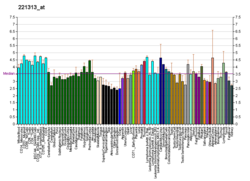
KNOWPIA
WELCOME TO KNOWPIA
Summary
Probable G-protein coupled receptor 52 is a protein that in humans is encoded by the GPR52 gene.[5][6]
| GPR52 | |||||||||||||||||||||||||||||||||||||||||||||||||||
|---|---|---|---|---|---|---|---|---|---|---|---|---|---|---|---|---|---|---|---|---|---|---|---|---|---|---|---|---|---|---|---|---|---|---|---|---|---|---|---|---|---|---|---|---|---|---|---|---|---|---|---|
| Identifiers | |||||||||||||||||||||||||||||||||||||||||||||||||||
| Aliases | GPR52, G protein-coupled receptor 52 | ||||||||||||||||||||||||||||||||||||||||||||||||||
| External IDs | OMIM: 604106 MGI: 3643278 HomoloGene: 74561 GeneCards: GPR52 | ||||||||||||||||||||||||||||||||||||||||||||||||||
| |||||||||||||||||||||||||||||||||||||||||||||||||||
| |||||||||||||||||||||||||||||||||||||||||||||||||||
| |||||||||||||||||||||||||||||||||||||||||||||||||||
| |||||||||||||||||||||||||||||||||||||||||||||||||||
| |||||||||||||||||||||||||||||||||||||||||||||||||||
| Wikidata | |||||||||||||||||||||||||||||||||||||||||||||||||||
| |||||||||||||||||||||||||||||||||||||||||||||||||||
Members of the G protein-coupled receptor (GPR) family play important roles in signal transduction from the external environment to the inside of the cell.[supplied by OMIM][6]
Cannabidiol, CBD, and O-1918 are Inverse agonist at GPR52[7]
References edit
- ^ a b c GRCh38: Ensembl release 89: ENSG00000203737 – Ensembl, May 2017
- ^ a b c GRCm38: Ensembl release 89: ENSMUSG00000118401 – Ensembl, May 2017
- ^ "Human PubMed Reference:". National Center for Biotechnology Information, U.S. National Library of Medicine.
- ^ "Mouse PubMed Reference:". National Center for Biotechnology Information, U.S. National Library of Medicine.
- ^ Sawzdargo M, Nguyen T, Lee DK, Lynch KR, Cheng R, Heng HH, George SR, O'Dowd BF (Mar 1999). "Identification and cloning of three novel human G protein-coupled receptor genes GPR52, PsiGPR53 and GPR55: GPR55 is extensively expressed in human brain". Brain Res Mol Brain Res. 64 (2): 193–8. doi:10.1016/S0169-328X(98)00277-0. PMID 9931487.
- ^ a b "Entrez Gene: GPR52 G protein-coupled receptor 52".
- ^ Stott LA, Brighton CA, Brown J, Mould R, Bennett KA, Newman R, Currinn H, Autore F, Higueruelo AP, Tehan BG, MacSweeney C (2021-06-01). "Characterisation of inverse agonism of the orphan-G protein-coupled receptor GPR52 by cannabinoid ligands Cannabidiol and O-1918". Heliyon. 7 (6): e07201. Bibcode:2021Heliy...707201S. doi:10.1016/j.heliyon.2021.e07201. ISSN 2405-8440. PMC 8219759. PMID 34189291.
Further reading edit
- Strausberg RL, Feingold EA, Grouse LH, et al. (2003). "Generation and initial analysis of more than 15,000 full-length human and mouse cDNA sequences". Proc. Natl. Acad. Sci. U.S.A. 99 (26): 16899–903. Bibcode:2002PNAS...9916899M. doi:10.1073/pnas.242603899. PMC 139241. PMID 12477932.
- Gerhard DS, Wagner L, Feingold EA, et al. (2004). "The status, quality, and expansion of the NIH full-length cDNA project: the Mammalian Gene Collection (MGC)". Genome Res. 14 (10B): 2121–7. doi:10.1101/gr.2596504. PMC 528928. PMID 15489334.
- Gregory SG, Barlow KF, McLay KE, et al. (2006). "The DNA sequence and biological annotation of human chromosome 1". Nature. 441 (7091): 315–21. Bibcode:2006Natur.441..315G. doi:10.1038/nature04727. PMID 16710414.







